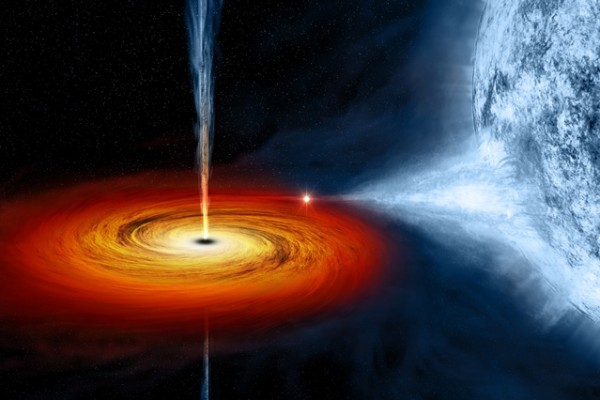MIT Scientists Create Alogrithm to Demystify Image of Black Hole
| Ana Verayo | | Jun 07, 2016 03:33 AM EDT |
(Photo : M.Weiss/NASA/CXC/MIT) An artist's drawing a black hole named Cygnus X-1. It formed when a large star caved in. This black hole pulls matter from the blue star beside it.
It's already hard to imagine what a supermassive balck hole looks like and now, scientists from the Massachusetts Institute of Technology have come up with a new computer algorithm that can help visualizing one of the most mysterious, powerful and colossal cosmic objects in the universe.
Like Us on Facebook
In order to view one, a giant, powerful telescope is needed to observe a black hole which will appear surprisingly small since it is so distant. For example, the supermassive black hole located in the core of the Milky Way galaxy is estimated to be 17 times the diameter of our sun with a distance of 25,000 light years away and this means that a giant telescope is needed to view this one, so large that the entire Earth can fit inside it.
According to MIT's Katie Bouman, since this gigantic telescope the size of our planet is impossible to build, this is not the only way humans can view a black hole. Bouman and her team have devised a way by using an array of telescopes known as the Event Horizon Telescope project to collect data simultaneously from a multitude of telescopes that are located in different regions on the planet.
Scientists will then combine all this data, that can equate to a giant telescope the size of Earth, as this method is known as the Very Long Baseline Interferometry. With this deluge of data, scientists will now have to figure out how to translate this data and filter it along with the Earth's atmospheric conditions into a more concrete image of a black hole.
This algorithm has been generated by MIT's CHIRP (Continuous High-resolution Image Reconstruction using Patch priors) that utilizes other images from space as crucial references to create a mosaic, that also coincides with the data obtained from all of these telescopes.
VLBI data can also be deciphered using other algorithms however, it results in blurry images, where this large amount of data becomes too overwhelming to produce a clear picture. With CHIRP, this new algorithm can filter out only the important data needed compared to past algorithms, that can transform this large amount of data into higher resolution images.
When all of the Event Horizon Telescope data are consolidated, the team will continue to update and improve CHIRP to further analyze how black holes evolve over time and even measure their magnetic fields.
This new algorithm will be presented during the Computer Vision and Pattern Recognition conference this month.
TagsBlack Hole, new algorithm image black hole, supermassive black hole, MIT, algorithm black hole
©2015 Chinatopix All rights reserved. Do not reproduce without permission
EDITOR'S PICKS
-

Did the Trump administration just announce plans for a trade war with ‘hostile’ China and Russia?
-

US Senate passes Taiwan travel bill slammed by China
-

As Yan Sihong’s family grieves, here are other Chinese students who went missing abroad. Some have never been found
-

Beijing blasts Western critics who ‘smear China’ with the term sharp power
-

China Envoy Seeks to Defuse Tensions With U.S. as a Trade War Brews
-

Singapore's Deputy PM Provides Bitcoin Vote of Confidence Amid China's Blanket Bans
-

China warns investors over risks in overseas virtual currency trading
-

Chinese government most trustworthy: survey
-

Kashima Antlers On Course For Back-To-Back Titles
MOST POPULAR
LATEST NEWS
Zhou Yongkang: China's Former Security Chief Sentenced to Life in Prison

China's former Chief of the Ministry of Public Security, Zhou Yongkang, has been given a life sentence after he was found guilty of abusing his office, bribery and deliberately ... Full Article
TRENDING STORY

China Pork Prices Expected to Stabilize As The Supplies Recover

Elephone P9000 Smartphone is now on Sale on Amazon India

There's a Big Chance Cliffhangers Won't Still Be Resolved When Grey's Anatomy Season 13 Returns

Supreme Court Ruled on Samsung vs Apple Dispute for Patent Infringement

Microsoft Surface Pro 5 Rumors and Release Date: What is the Latest?










